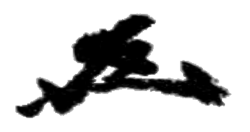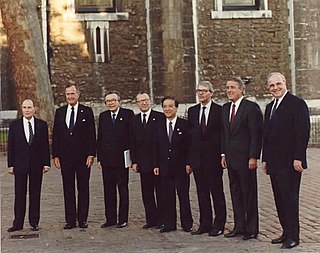Toshiki Kaifu
Prime Minister of Japan from 1989 to 1991 From Wikipedia, the free encyclopedia
Toshiki Kaifu (海部 俊樹, Kaifu Toshiki, 2 January 1931 – 9 January 2022) was a Japanese politician who served as prime minister of Japan from 1989 to 1991.
Toshiki Kaifu | |
|---|---|
海部 俊樹 | |
 Official portrait, 1989 | |
| Prime Minister of Japan | |
| In office 10 August 1989 – 5 November 1991 | |
| Monarch | Akihito |
| Preceded by | Sōsuke Uno |
| Succeeded by | Kiichi Miyazawa |
| President of the Liberal Democratic Party | |
| In office 8 August 1989 – 30 October 1991 | |
| Secretary-General | |
| Preceded by | Sōsuke Uno |
| Succeeded by | Kiichi Miyazawa |
| Minister of Finance [citation needed] | |
| In office 14 October 1991 – 5 November 1991 [citation needed] | |
| Preceded by | Ryutaro Hashimoto |
| Succeeded by | Tsutomu Hata |
| Minister of Education | |
| In office 28 December 1985 – 22 July 1986 [citation needed] | |
| Prime Minister | Yasuhiro Nakasone |
| Preceded by | Hikaru Matsunaga |
| Succeeded by | Masayuki Fujio |
| In office 24 December 1976 – 28 November 1977 [citation needed] | |
| Prime Minister | Takeo Fukuda |
| Preceded by | Michio Nagai |
| Succeeded by | Shigetami Sunada |
| Preceded by | Seiroku Kajiyama |
| Succeeded by | Hyosuke Kujiraoka |
| Member of the House of Representatives | |
| In office 20 November 1960 – 21 July 2009 | |
| Preceded by | Multi-member district |
| Succeeded by | Mitsunori Okamoto |
| Constituency | Aichi 3rd (1960–1996) Aichi 9th (1996–2009) |
| Personal details | |
| Born | 2 January 1931 Nagoya, Japan |
| Died | 9 January 2022 (aged 91) Tokyo, Japan |
| Political party | Liberal Democratic (1960–1994; 2003–2022) |
| Other political affiliations | New Frontier (1994–1997) Independent (1997–1998) Liberal (1998–2000) New Conservative (2000–2003) |
| Spouse | |
| Children | 2 |
| Alma mater | Chuo University Waseda University |
| Signature |  |
Born in Nagoya, Kaifu graduated from Waseda University and was first elected to the Diet in 1960 as a member of the Liberal Democratic Party. He served as education minister from 1976 to 1977 under Takeo Fukuda, and from 1985 to 1986 under Yasuhiro Nakasone. In 1989, Kaifu became prime minister after the resignations of the last two premiers, Noboru Takeshita and Sosuke Uno, amid various scandals; he was chosen in part because of his clean image. During his tenure, Kaifu worked to improve relations with China and made large financial contributions to the coalition in the Persian Gulf War. After his attempts at political reform were unsuccessful, Kaifu resigned as prime minister in 1991 and was replaced by Kiichi Miyazawa.
Early life and education
Kaifu was born on 2 January 1931, in Nagoya City, the eldest of six brothers. His family's business Nakamura Photo Studio was established by his grandfather in the Meiji era, and was situated next to the Matsuzakaya flagship department store.[1]
Kaifu took the exam to the Aichi Prefectural Asahigaoka Senior High School, and while of the eleven students who took the test from the same school, nine were accepted and two, including Kaifu, were not. As part of the student labor mobilization during the war, he was placed in a Mitsui Heavy Industry factory where he assembled airplane engine parts day and night. In 1945, he was accepted in the Youth Airman Academy of the Imperial Japanese Army, but the war ended before his planned enrolment in October.[1] He was then educated at Chuo University and Waseda University.[2]
Political career
A member of the Liberal Democratic Party (LDP), Kaifu ran successfully for the 1960 Japanese general election and took office as the youngest member of the National Diet.[3] He served for sixteen terms, totaling 48 years.[4]
Kaifu was education minister before rising to lead the party after the resignations of Takeshita Noboru and Sōsuke Uno.[5] Facing Yoshiro Hayashi and Shintaro Ishihara,[6] Kaifu was elected on the platform of clean leadership.[7][8] He became the 76th Prime Minister of Japan in August 1989.[9]
Premiership (1989–1991)
Summarize
Perspective

On 10 August 1991, Kaifu became the first leader of a major country to make an official visit to China and break China's diplomatic isolation after the 1989 Tiananmen Square protests and massacre.[10] Kaifu ended Japan's participation in economic sanctions against China and offered $949.9 million in loans and an additional $1.5 million in emergency aid following flood damage in southern China in June and July.[11] In 1991 he sent the Maritime Self-Defense Force to the Persian Gulf in the wake of the Gulf War.[12]
Throughout his two Cabinets, Kaifu's faction was too small to push through the reforms he sought, and the continuing repercussions of the Sagawa Express scandal caused problems. He resigned in November 1991 and was replaced by Kiichi Miyazawa.[13]
In 1994, he left the LDP to become head of the newly-founded New Frontier Party.[14][15] He was then nominated by Ichirō Ozawa and Tsutomu Hata as prime minister in June 1994 against the LDP-Socialist coalition candidate Tomiichi Murayama but lost in the Diet vote. He supported Ozawa's party until he returned to LDP in 2003.[16] He was defeated in the election of 2009 by DPJ candidate Mitsunori Okamoto,[17] which witnessed the end of almost uninterrupted LDP dominance since 1955.[18] At the time of his defeat, he was the longest-serving member of the lower house of the Diet, and he was also the first former prime minister to be defeated at a re-election since 1963.[19]
Personal life
On 17 November 1957, Kaifu married Sachiyo Yanagihara, a female assistant to Member of the House of Representatives.[1][20] The couple had a son, Masaki, and a daughter, Mutsumi.
Death
Kaifu died of pneumonia at a Tokyo hospital on 9 January 2022, at the age of 91. The announcement of his death to the media was delayed until 14 January.[21][22][23]
Honours
- Grand Cross of the Order of the Sun of Peru (1989)[24]
Election history
| Election | Age | District | Political party | Number of votes | election results |
|---|---|---|---|---|---|
| 1960 Japanese general election | 29 | Aichi 3rd district | LDP | 49,767 | winning |
| 1963 Japanese general election | 32 | Aichi 3rd district | LDP | 57,586 | winning |
| 1967 Japanese general election | 36 | Aichi 3rd district | LDP | 80,874 | winning |
| 1969 Japanese general election | 38 | Aichi 3rd district | LDP | 82,695 | winning |
| 1972 Japanese general election | 41 | Aichi 3rd district | LDP | 87,733 | winning |
| 1976 Japanese general election | 45 | Aichi 3rd district | LDP | 151,151 | winning |
| 1979 Japanese general election | 48 | Aichi 3rd district | LDP | 119,049 | winning |
| 1980 Japanese general election | 49 | Aichi 3rd district | LDP | 145,322 | winning |
| 1983 Japanese general election | 52 | Aichi 3rd district | LDP | 123,415 | winning |
| 1986 Japanese general election | 55 | Aichi 3rd district | LDP | 133,829 | winning |
| 1990 Japanese general election | 59 | Aichi 3rd district | LDP | 195,713 | winning |
| 1993 Japanese general election | 62 | Aichi 3rd district | LDP | 194,863 | winning |
| 1996 Japanese general election | 65 | Aichi 9th district | NFP | 111,578 | winning |
| 2000 Japanese general election | 69 | Aichi 9th district | NCP | 122,175 | winning |
| 2003 Japanese general election | 72 | Aichi 9th district | NCP | 104,075 | winning |
| 2005 Japanese general election | 74 | Aichi 9th district | LDP | 130,771 | winning |
| 2009 Japanese general election | 78 | Aichi 9th district | LDP | 100,549 | lost |
| [25][26] | |||||
References
External links
Wikiwand - on
Seamless Wikipedia browsing. On steroids.
